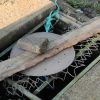
Ingredients
- 2 litres milk — whole or 2% are best, but skim can also be used
- 1/2 cup commercial yoghurt containing active cultures
Equipment
- Heavy saucepan with a lid
- Spatula
- Instant-read thermometer (one that can clip to the side of the pan)
- Small measuring cup or small bowl
- Whisk
Instructions
- Heat the milk. Pour the milk into the pan and set over medium to medium-high heat. Warm the milk to right below boiling, about 95°C. Stir the milk gently as it heats to make sure the bottom doesn’t scorch and the milk doesn’t boil over.
- Cool the milk. Let the milk cool until it is just warm to the touch, 45°C. Stir occasionally to prevent a skin from forming.
- Thin the yogurt with milk. Scoop out about a cup of warm milk with a measuring cup and add the yoghurt. Whisk until the yoghurt is dissolved.
- Whisk the thinned yoghurt into the milk. Pour the thinned yoghurt into the warm milk while whisking gently. This inoculates the milk with the yoghurt culture.
- Transfer the pot to the (turned-off) oven. Cover with the lid and place the whole pot in a turned-off oven – turn on the oven light or wrap the pot in towels to keep the milk warm as it sets (ideally around 45°C, though some variance is fine).
- Wait for the yoghurt to set. Let the yoghurt set for at least 4 hours or overnight – the exact time will depend on the cultures used, the temperature of the yoghurt, and your preference. The longer yoghurt sits, the thicker it becomes.
- Cool the yoghurt. Once the yoghurt has set to your liking, remove it from the oven. If you see any watery whey on the surface of the yoghurt, you can either drain this off or whisk it back into the yoghurt before transferring to containers. Refrigerate.

Notre service WhatsApp. Vous êtes témoins d`un événement d`actualité ou d`une scène insolite? Envoyez-nous vos photos ou vidéos sur le 5 259 82 00 !















![[Blog] End of the year report on L’Alliance du Changement](https://files.defimedia.info/sites/default/files/styles/square_thumbnail/public/181225_changement.jpg?itok=5hxmMfd5)





